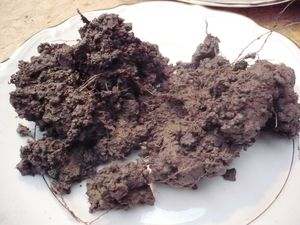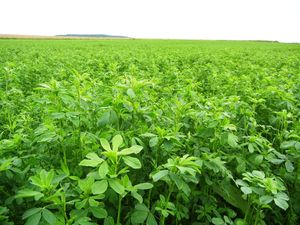Essay: ‘How do social scientists construct knowledge, and how does this compare with natural
sciences’ Sociology of Knowledge & Development, MSc Development & Rural Innovation
Prof. Paul Hebinck & Alberto Arce Vincent Delobel
Wageningen University Period 1, Academic year 2012-2013
Soil: A Matter of Perspective
“The nation that destroys its soil destroys itself.”
[Franklin D. Roosevelt]
“Emancipation from the bondage of the soil is no freedom for the tree.”
[Rabindranath Tagore]
Introduction
Central in agronomy and in plant science but also the object of multiple perceptions and representations in the minds of the individuals who make a living from it, the soil seemed to be a relevant topic to compare the different ways through which natural and social sciences construct knowledge. In this essay, I will focus on how different people evaluate the soil quality.
The soil quality of a single field can be, more or less deliberately, observed, perceived and understood differently by a natural scientist (e.g. the lab analyst) and the farmer. In this essay, I assume on the one hand that the hypothetical social scientist, who might have encountered this story, chooses the EMIC perspective and uses the farmer’s “indigenous” concepts, and in the other hand, that the lab analyst uses his own “external” concepts. This divergence may imply the production of different knowledge about a single phenomenon that may differ, conflict and suggest different “solutions” or actions.
The story I refer to comes from my own experience on my parent’s farm. Amateurs of on-farm experiments, we wanted to plant trees on a plot to evaluate the potential of Agroforestry in our crop rotation (soil productivity, ecosystem services, energy issue, timber production...). Taking advice of agronomists, we ordered a soil analysis ex ante in order to evaluate the soil quality before the trees could influence it. As farmers, we had another way to evaluate it and we interpreted the soil analysis results differently than how the lab analyst did. In the following sections, I will describe, analyse and then compare these two different ways to evaluate the soil quality and to interpret the analysis results.
Observations
In this section, I will first describe how the natural scientist evaluates the soil quality via the soil chemical analysis and then, how a social scientist could have done so, for instance, via participant observation.
· The approach of the natural scientist (ETIC discourse)
First of all, the soil analysis is based on a soil sample provided by the farmer. This sample must weigh five hundred grams and contains, in a plastic bag, diverse extracts of the superficial layer from different places in the field. The transport of the soil in this container keeps the chemical properties constant but changes the soil structure. The farmers also provides information about the crop rotation, but the experts only consider the previous and the current use which does not suit for our five-year crop rotation.
Then, in the lab of CARAH[1], the analyst carries out a chemical analysis. This is the only sort of soil analysis the Provincial Centre for Agriculture offers. The sample is used for several analyses to measure its pH and the content in phosphorus, potassium, magnesium, calcium, sodium, carbon (%), humus (%), organic nitrogen, and the C/N ratio. Among these parameters, many are not effectively observable with the eyes; the chemical analysis is a technology that permits the acquirement of unobservable information and then, it may complement farmer’s visual observation. The farmer cannot decide which parameter will be analysed; this is the standard list for agricultural soil analysis. It both implies and assumes that, theoretically, the farmers of the Province only consider these chemical parameters of their soils.
The outputs of the analysis are figures. The report the farmer receives also provides an interpretation of these figures: each one is compared to a “desirable content”. A kind of diagram shows the situation of the sample compared to the pre-defined standards calculated by experts. These standards are neither defined in relation to the farming system nor the crop rotation. I will go back over the issue of “neutrality” of these standards later. From the interpretation of figures (i.e. comparison between the results and the standards), the expert advises the farmer to undertake certain actions, for example: to increase one chemical compound, to diminish another, assuming all the farmers have access to those compounds, in powder form.
· The approach of the farmer and therefore the understanding of the social scientist (EMIC perspective)
Obviously, the farmer’s evaluation of the soil quality is based on different indicators than chemical parameters. With a spade, the farmer can dig into the soil fifty centimetres deep and observes the structure, the texture, the colour, the presence of organisms and roots. Another “knowledge input” which is worth considering is the odour of the soil which gives information about the decomposition and the microorganisms. These abilities to observe are also limited (e.g. scale) and imply “subjective” appreciation, i.e. interpretation of more or less qualitative information by the farmer himself.
The farmer’s evaluation also takes place in a particular spatiotemporal context. The farmer considers not only the current parameters but also the broader context: his farming system, the crop rotation (notably the legumes), the presence of trees or hedges and the story of the plot. Who cultivated it in the past? Under what kind of contract? In what farming system? Organic agriculture or not? He relates it to his own history and ancestors: “I know there was a hedge before but my father pulled it”, “This field has always been dry”... This historical perspective gives information about the evolution and the changes that occur on the field as well as about the meaning(s) the farmer gives to this resource and the inherited means of evaluation of land. Thus, in order to know the quality of the soil, the farmer links varied natures and sources of information.
Argumentation
Through three sub-headings, this section seeks to go deeper in the analysis and the argumentation about the underlying issue of the different modes of knowledge construction.
A fundamental difference between the natural and the social sciences is what they consider as relevant and reliable source of information. The lab analyst bases his analysis mostly on the soil sample (only considered in its material dimension) and, to a lesser extent, on the written information given by the farmer about the land use. His interpretation consists in the comparison of the figures the chemical analysis provided and the standards his institution considers as relevant. Risking being irrelevant, he advises the farmer on the basis of “invisible” information he found in this five-hundred-grams-piece of soil.
Via participant observation, the social scientist considers several sources of information: he listens to the farmer’s discourse (about the story of land use, the long-term vision of the farmer, the farm system, the crop rotation); he can smell the soil as the farmer does (even if he probably will not perceive the same things) and he can observe (visually) the colour, the structure, the texture, the presence of roots and organisms in the soil. Because he has (maybe) no background in agronomy, he is not able to interpret these indicators by himself but he has access to the farmer’s interpretation and concepts to evaluate the soil quality.
As Showers (2005) [2]says, “landscapes are libraries whose info is ignored by most academics”. Through the study of soil erosion in Lesotho, he explains that the analyst cannot find the actual causes of soil erosion and fertility without listening to the story of people involved. In fact, the physical processes of soil formation and evolution can’t explain the current situation but the (changing) human land use disturbs also the chemical and physical properties of soil. Other methodologies are required to have access to this information, for instance, interviews and historical inquiries. In this case study, the author analyzed each element of history in relation to its potential impacts on soil, e.g. a change of farming system changes the meaning of resources and then how people use it. These complementary modes of inquiry and knowledge construction assume different relations with the “reliability” of sources and they may use concepts from different origins.
The lab analyst’s report mentioned different concepts to designate the inputs: fumure de redressement (= recovering manure), fumure de production (=manure for production) and fumure d’entretien (=maintenance manure). The use of these concepts is related to a specific farming system (currently dominant) characterised by the provision of several “external” inputs administered by “external experts”, outsiders, who are more often vendors. This issue illustrates the influence of the context on knowledge construction. Thus, in this case, the “external” concepts don’t help to understand the actual socio-technical reality of the soil. In epistemology, using “expert” concepts to construct knowledge characterises the Etic approaches.
On the other hand, the Emic approaches are characterised by the fact that (social) scientists use the “indigenous” concepts to understand the “lived-reality”. In this case, the social scientist would have understood differently the issue of inputs. Thanks to the interviews, he knows the farming system and the related paradigm the farmer has opted for. The importance of external inputs is totally different on an organic farm where the goal is the autonomy and the long-run productivity of the soil instead of the optimization of the short-term plant productivity. The conception of input and output is a bit more complex: the lucerne (alfalfa, legume) is both considered as a short-term output (fodder crop) and a long-term input (nitrogen fixation); as well as the recently planted trees are considered as short-term input (leaves and roots renewal) and long-term output (timber production). As these last two elements of the agro ecosystem, the compost symbolizes broadly the “gift back” from the farmer to his soil, given every year in autumn. Its compounds reflect, to a certain extent, the portrait of the farm as a whole: residues from hedge cut, droppings of the different animals of the farm, the soiled straw... The farmer gives particular meanings to these elements and behaves particularly with the compost. These meanings are related to the farmer’s conception of his fields, his farm, and his role in the agro ecosystem. Listening to the farmer’s discourse enables the social scientist to access to these meanings and so, to understand this particular reality. Indeed, the last concepts are both not universal. In order to understand the farming practices, Shipton (1994)[3] suggests to “link religion and economy, ritual and subsistence, sacred and profane” and to study urban-rural linkages instead of focusing on fertility and management issues separately from socio-cultural context. Similarly, in the case presented in this essay, the understanding of farmer’s practices and objectives requires to consider also symbolic dimensions (e.g. the compost) and rural-urban linkages (e.g. the ecosystem services, high-quality food market).
Not only there exist several ways to evaluate soil quality but there are also different ways to interpret the results of a single chemical lab analysis. What is the “desirable” content? What is considered as an important compound? What is the meaning of a resource? The domain of interpretation is full of assumptions, even in the “expert” discourse. I will illustrate this with the interpretation of two figures: the C/N ratio and the phosphorus content.
Firstly, the C/N ratio (carbon/nitrogen) gives information about the speed of the manure mineralisation. The result of this analysis is superior to the level considered “desirable” by the Centre. So, experts consider that, in this field, the mineralisation is too slow. In the soil sample, they can’t read the farmer’s intention to plant trees (that prefer higher C/N level) and his farming system that gives priority to the soil structure. These pieces of information are important to properly advise the farmer in his decisions but they are not accessible via this source of information. The scientist primarily chooses the sources he wants to build knowledge on and the sources imply certain kinds of information. The latter will influence the process of knowledge construction.
Secondly, the figure of phosphorus content is particularly surprising. 14,6mg/100g, more than three times the “desirable” content. The report doesn’t comment it but the farmer is really proud of it. Why? Thanks to his personal sources of information and his social relations with (in this case) academicians, the farmers knows that phosphorus is an essential compound of the soil for plants that soil erosion alters. In ‘conventional’ agriculture systems, this loss can be made up by the application of external phosphorus input but it is forbidden in organic agriculture. Moreover, this farmer knows that the world stock of this non-renewable resource is threatened by the agricultural input industry. Therefore, he is very proud of having ‘naturally’ this high content in phosphorus in his soil and considers it as an important resource that he manages to preserve for the future.
According to Oudwater & Martin (2003)[4], “indigenous knowledge includes the complex of practices and decisions made by local people. It is based on experience passed from one generation to the next, but nevertheless, it changes, adapts and assimilates new ideas”. Obviously, this knowledge is contextual: created, modified, shared and transmitted within specific social and agro-ecological contexts. But it is not “static and unchanging entities that do not interact with the ‘outside world’”. The example of the meaning and value of phosphorus in the soil illustrates this interaction between local knowledge and the ‘external’ ‘scientific’ knowledge; through special occasions (reflection days, etc.) this farmer had the opportunity to synchronize his knowledge with the knowledge of scientists and both learned from each other, with both kinds of knowledge influencing one another.
Through these two examples, I tried to illustrate the importance of the context and the assumptions in the construction of knowledge, and therefore the difference between social and natural sciences approaches of a single phenomenon.
Conclusion
To conclude this essay, I would like to come back on three points: how natural and social sciences complement each other, their relation to local knowledge and their scope.
Firstly, natural and social sciences are characterised by different conceptions and methods of knowledge construction: different sources of information, different origins of concepts and different interpretations. They offer various insights that may be complementary and helpful to understand the problematic situation. In the case of soil quality evaluation, the chemical analysis provided visually-unobservable information while the interview taught more about the historical, political, economical and cultural context. The broader the range of information is, the deeper the understanding can be.
Secondly, the two “families” of sciences often have a contrasting approach towards local knowledge. As the case illustrates, natural scientists neglect too often the local knowledge even in the perspective of solving of local problems. On the opposite, in sociology, the Emic perspective considers this knowledge as an entry point, a source of concepts, meanings, linkages, that is worth listening to. In fact, to ignore the farming system, which I consider as a local concept, may lead to improper interpretation of data and therefore, irrelevant advice given to the farmer. This story illustrates the importance of considering local knowledge and so, the relevance of social scientists as “facilitators” in order to understand better agricultural problematic situations.
Finally, the scope of a theory is always limited. Actually, the construction of knowledge is a process that always happens in a particular context. This environment may be characterised by particular actors’ interests (e.g. external inputs market), certain paradigms (e.g. Modernization of Agriculture, the Green Revolution) but also by the absence of certain issues in the discussions (e.g. environmental externalities). Thus, according to Gil-Stores[5] (2004), even in the natural sciences, there is no consensus on the use and the interpretation of soil quality indicators. In addition, these characteristics may evolve over time and therefore influence differently the construction of knowledge. The social sciences, through their particular tools and methodologies, can really help to assess these interactions and influences. A particular theory, model or knowledge cannot claim to be totally universal and even less to be superior in every respect. The relation between the knowledge and its context challenges the concept of “expertise” and suggests the scientists both to be more humble and to consider better local knowledge.
References
· Gil-Sotres, F., Trasar-Cepeda C., Leiros, S. Seoane M.C. (2004), Different approaches to evaluating soil quality using biochemical properties. In: Soil Biology & Biochemistry 37 (2005) 877–887.
· Oudwater, N. and A. Martin, Methods and issues in exploring local knowledge of soils. Geoderma, 2003. 111(3-4): p. 387-401.
· Shipton, P., Land and Culture in Tropical Africa: soils, symbols and the metaphysics of the Mundane. Annual Review of Anthropology, 1994. 23: p. 367-368.
· Showers, K.B., Imperial gullies: soil erosion and conservation in Lesotho. 2005, Athens, : Ohio University Press.
Annexe: Soil analysis
[1] Centre pour l’Agronomie et l’Agro-industrie de la province de Hainaut (= Centre for Agronomy and Agro-industry in Province of Hainaut)
[2] Showers, K.B., Imperial gullies: soil erosion and conservation in Lesotho. 2005, Athens, : Ohio University Press.
[3] Shipton, P., Land and Culture in Tropical Africa: soils, symbols and the metaphysics of the Mundane. Annual Review of Anthropology, 1994. 23: p. 367-368.
[4] Oudwater, N. and A. Martin, Methods and issues in exploring local knowledge of soils. Geoderma, 2003. 111(3-4): p. 387-401.
[5] Gil-Sotres, F., Trasar-Cepeda C., Leiros, S. Seoane M.C. (2004), Different approaches to evaluating soil quality using biochemical properties. In: Soil Biology & Biochemistry 37 (2005) 877–887.
commenter cet article …



























/idata%2F4096338%2FCrops-May-2013%2FDSC01090.JPG)
/idata%2F4096338%2FTransition-P.-Temporaire---Cereales%2FDSC00730.JPG)
/idata%2F4096338%2FHersage-des-prairies---Traction-chevaline%2FDSC00266.JPG)
/idata%2F4096338%2FPremiere-parcelle-agroforesterie%2FDSC00228.JPG)
/idata%2F4096338%2F6--Tour-des-cultures---Novembre-2011%2FDSCN1191.JPG)
/idata%2F4096338%2FTour-des-cultures---Octobre-2011%2FDSCN1146.JPG)

